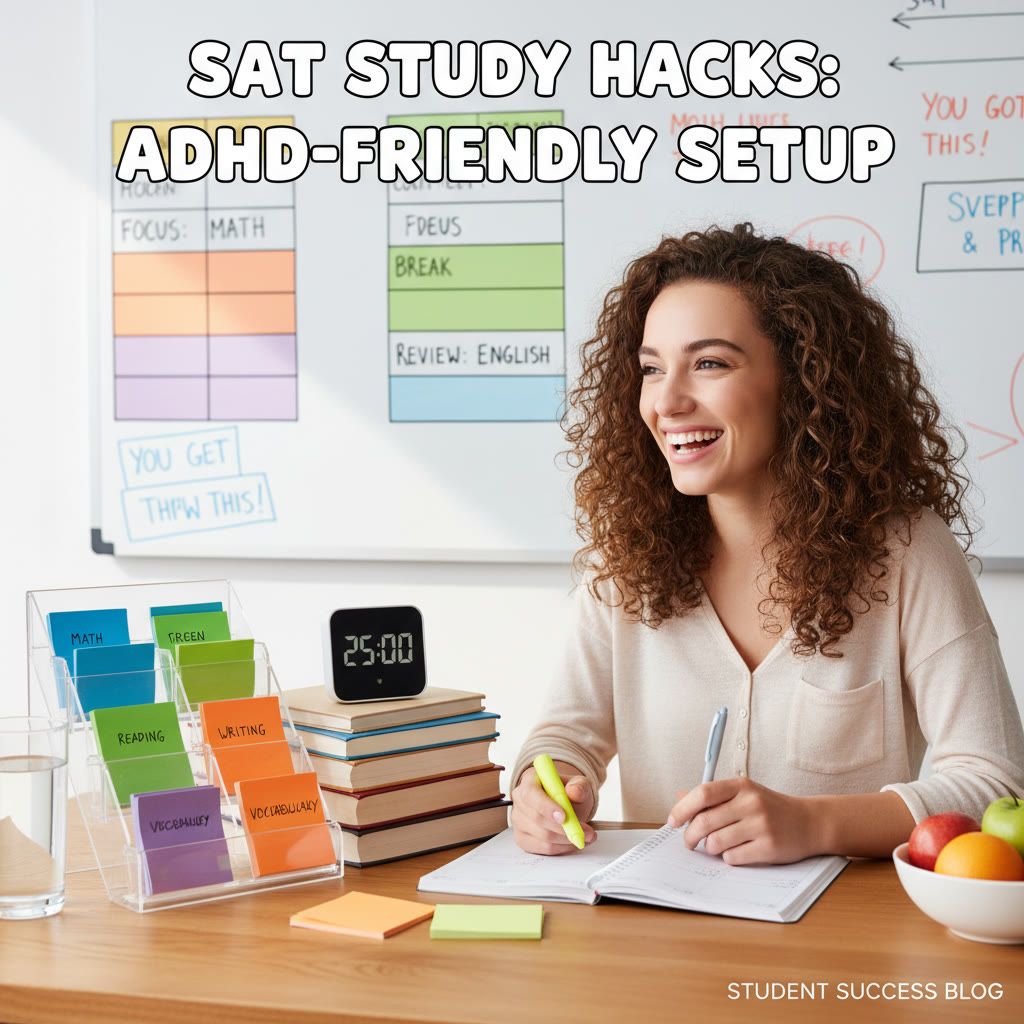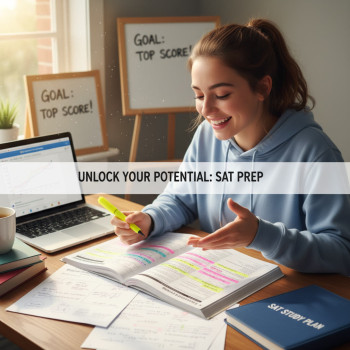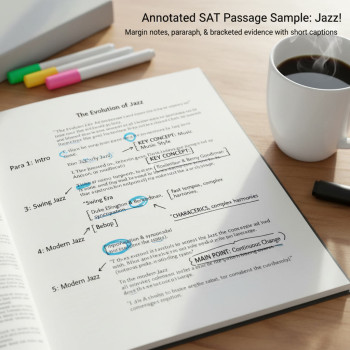How to Handle SAT Prep With ADHD or Attention Challenges
Preparing for the SAT can feel like climbing a mountain even on a calm day. If you have ADHD or struggle with attention, it can feel more like climbing that mountain while someone occasionally changes the route under your feet. The good news: ADHD doesn’t mean you can’t do great on the SAT. It means you’ll benefit from strategies and structures that match how your brain actually works.
Why a different approach helps
ADHD often affects attention, working memory, processing speed, and executive functioning skills such as planning and task initiation. Those are exactly the skills the SAT tests indirectly: sustained focus through long sections, juggling multiple steps in problem solving, and managing time across passages and math problems.
But here’s the important part: understanding these tendencies lets you design a study plan that plays to your strengths—energy, creativity, and big-picture thinking—while scaffolding or bypassing the tougher bits.
Start with calm clarity: assessment and mindset
Take a gentle inventory
Before you spend a lot of time on practice tests, do a short, honest assessment. What exactly drains your focus? Is it long, uninterrupted sittings? Distracting environments? Not knowing where to start? Test anxiety? Pinpointing the main pain points helps you choose targeted tactics.
Set realistic, motivating goals
Swap vague goals (“study more”) for concrete, bite-sized goals (“complete two focused Reading science passages on Thursday using the 15/5 split”). Small wins build momentum and reduce the intimidation factor that often triggers avoidance.
Design study sessions that respect attention spans
Quality over marathon hours
Long, unfocused study blocks are a recipe for frustration. Instead, favor shorter, more intense bursts. Many students with attention challenges find 15–30 minute focused sessions, followed by a 5–15 minute break, work far better than three-hour marathons.
- Try a flexible Pomodoro: 20 minutes work, 7 minutes break for tougher days; 25/5 or 30/10 on better focus days.
- Keep a visible timer—counting down is more motivating than counting up.
- Use breaks to move: stretching, a quick walk, or a sensory reset helps your brain return to focus.
Layer tasks to keep momentum
Alternate active tasks (solving problems, annotating passages) with passive review (reading explanations, flashcards). The alternation keeps your brain engaged because it varies the cognitive load and sensory input.
Practical techniques for specific SAT sections
Reading
Reading passages can be especially challenging if attention drifts. Build habits that reduce decision fatigue and increase comprehension.
- Pre-scan the questions quickly (30–60 seconds) to get a sense of what to look for.
- Annotate actively: underline claims, circle transition words, and jot margin notes. Active processing beats passive skimming.
- Practice with a stopwatch in training: target one passage at a time and gradually reduce time while keeping accuracy steady.
Writing & Language
Errors here are mostly pattern-based. Train pattern recognition instead of trying to parse every sentence from scratch.
- Make checklists for common grammar rules: subject-verb agreement, parallelism, comma usage, and concise phrasing.
- Use color-coding in practice: highlight verbs one color, subjects another. The visual cue supports working memory.
Math
Math questions vary between quick, recall-based problems and complex multistep problems. Strategize accordingly.
- Start with questions you can answer quickly to build confidence and bank time.
- Write short, structured notes for multi-step problems: list what you know, what you need, and the operations you’ll use.
- Use scratch paper efficiently: a clean, consistent layout reduces cognitive load and prevents mistakes.
Study schedules and routines that actually stick
Make a weekly plan, not a vague wish
Consistency beats intensity. Block specific times in your week for SAT tasks—two or three focused sessions several days a week is better than random cramming. Build study into your daily rhythm so it becomes normal, not exceptional.
Sample weekly plan
Below is a simple, realistic plan you can adapt. The key is variety and predictability.
| Day | Session 1 | Session 2 | Evening |
|---|---|---|---|
| Monday | 20–30 min Reading passages (annotate) | 15–20 min Vocabulary review/flashcards | Light review: note mistakes |
| Tuesday | 25 min Math problem set (focus on algebra) | 10–15 min targeted grammar checklist | Relaxing activity (no study) |
| Wednesday | Timed practice: 1 Writing section (30–40 min) | Review explanations, log patterns of errors | Movement or exercise |
| Thursday | 20 min Mixed practice (quick questions) | 15 min mental math drills | Organize notes and set goals for Friday |
| Friday | Full timed Reading section simulation (with breaks) | Review missed questions | Light review and reward |
| Saturday | Practice test (half or full, depending on stamina) | Deep review session: analyze mistakes | Social or rest time |
| Sunday | Rest or gentle review (flashcards) | Plan next week: adjust based on progress | Mindfulness or relaxation |
Adjusting for fatigue and focus variability
Some days your focus will be great; other days it will be low. That’s normal. On low-focus days, swap in lighter tasks—flashcards, reading strategy reviews, or grading your practice instead of solving new problems. Treat low-focus days as productive in a different way.
Tools, environments, and supports that reduce friction
Control the study environment
- Reduce visual clutter. A clean, minimal desk reduces cognitive load.
- Use noise-cancelling headphones or ambient sound if background noise is a problem.
- Block distracting websites during study sessions with simple site-blockers or phone focus modes.
Use external structure
External structure—timers, checklists, and visible calendars—compensates for executive function gaps. Write every step down for tricky tasks: “Open practice test → set timer → complete section → review mistakes for 15 minutes.” Ticking off steps is motivating.
Technology that helps (without overwhelming)
- Digital flashcard apps with spaced repetition to make vocabulary stick.
- Simple timers that show countdowns prominently.
- Note apps that sync across devices so you’re never hunting for your notes.
Practice tests: smart, not frantic
Purposeful practice tests
Full practice tests are critical, but timing and review matter more than frequency. Initially, do shorter, targeted sections under test conditions to build stamina—then simulate full-length tests when you’re ready.
Review like a detective
When you review mistakes, ask: Did I know the content and make a careless error? Did I not understand the concept? Was time pressure the issue? Categorize each mistake and track patterns. That data tells you what to fix next.
Test-day strategies and accommodations
Use accommodations if you qualify
Many students with ADHD benefit from College Board accommodations like extended time, additional breaks, or a separate room. If you think you may qualify, begin the documentation process early—schools and testing boards require paperwork and lead time.
Test-day rituals to reduce anxiety
- Practice test-day timing in advance until it feels familiar.
- Prepare everything the night before: snacks, ID, extra pencils, permitted calculator, and a comfortable jacket.
- Use calming sensory tools—chewing gum (if allowed), a textured stress ball, or breathing exercises during breaks.
Self-care and executive function hygiene
Sleep, movement, and nutrition
These aren’t optional. Sleep consolidates memory, exercise increases focus by regulating neurotransmitters, and balanced meals stabilize energy. Treat them like study tools, not luxuries.
Small habits that add up
- Start sessions with a two-minute plan: write down the session goal.
- End sessions with a one-minute reflection: note what went well and one tweak for next time.
- Keep a “done” list rather than only a to-do list—this visualizes progress.
When to bring in a tutor or coach
Signs you’ll benefit from 1-on-1 help
If you repeatedly hit the same obstacles—stalled motivation, unclear study plans, or test anxiety—personalized guidance can be transformative. A tutor helps in three ways:
- Academic scaffolding: filling specific content gaps and teaching effective problem strategies.
- Study design: building a plan that fits your attention profile and schedule.
- Accountability and feedback: consistent check-ins that keep progress moving.
Personalized tutoring, like Sparkl’s 1-on-1 guidance, often includes tailored study plans, expert tutors who adapt to your pace, and AI-driven insights to highlight weak spots—tools that reduce wasted effort and increase confidence.
Examples and real-world practice
A case study: Maya
Maya was three months out from her SAT and burned out from two-hour nightly sessions that left her exhausted and discouraged. We broke her studying into four 20-minute bursts daily: one Reading passage, a grammar checklist, ten targeted math problems, and a brief vocabulary drill. She tracked errors in a simple spreadsheet and met once weekly with a tutor to adjust focus areas. Her accuracy improved steadily, and when she did a full practice test, stamina was the only surprise—something simple training and a mock-test day fixed.
A case study: Jamal
Jamal struggled with time management and test anxiety. He qualified for extended time after documentation and used it during practice to learn pacing. His tutor taught him a “first pass/second pass” approach for Math—answer all quick questions in the first pass and mark harder ones for return—and he practiced this method until it felt automatic. The combination of pacing strategy and extra real-world practice reduced anxiety on test day.
Tracking progress without pressure
Measure improvements in process, not just score
Focusing solely on score jumps can be discouraging. Track measures you can control: number of focused sessions completed, pattern elimination (fewer grammar errors of a certain type), or increased speed on specific question types. Scores will follow productivity and clarity.
Use a simple tracking table
| Metric | Week 1 | Week 4 | Goal |
|---|---|---|---|
| Focused sessions per week | 4 | 9 | 10 |
| Average accuracy on Reading passages | 60% | 75% | 80%+ |
| Time per math question (average) | 90s | 65s | 60s |
Final thoughts: design a plan that’s kind to your brain
Preparing for the SAT with ADHD is not about forcing your brain to be something it isn’t. It’s about creating a system that aligns with how you naturally focus, remember, and solve problems. Short, targeted sessions; external structure; smart practice tests; accommodations when needed; and consistent self-care change the game.
And you don’t have to do it alone. Personalized tutoring—like Sparkl’s one-on-one guidance—can help shape a plan that fits your rhythm, provide expert tutors who understand attention challenges, and offer AI-driven insights that focus your study time. The right support doesn’t remove the work, but it makes every minute of work count more.


Be patient with yourself. Small, steady changes compound. Celebrate the focused sessions, the patterns you’ve solved, and the resilience you build. With structure, strategy, and support, you can approach the SAT with confidence and clarity—on your terms.
















No Comments
Leave a comment Cancel